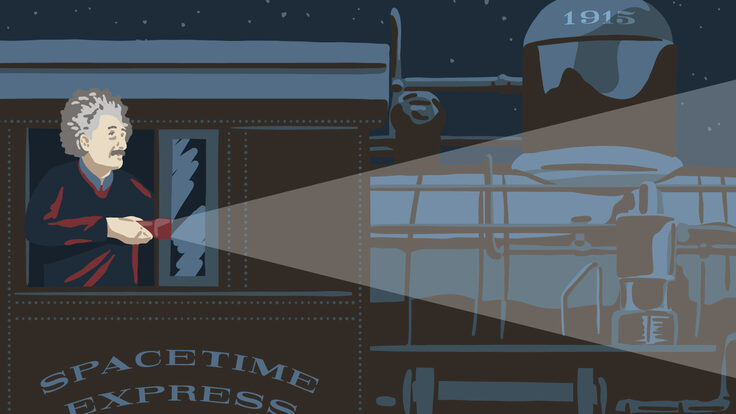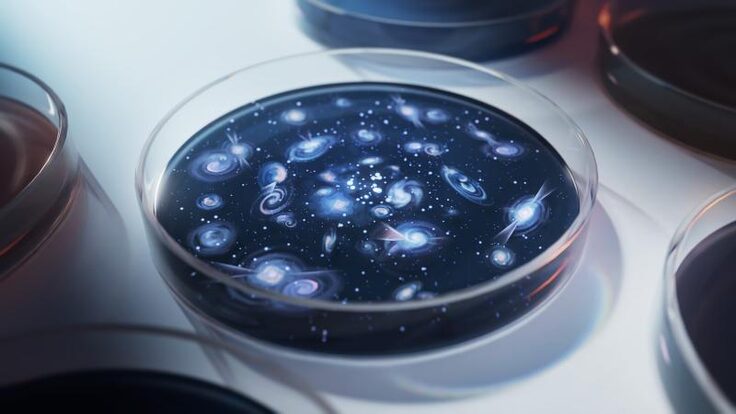With enough time and magnifying power, a telescope can gather all the light it needs to create a pretty complete portrait of a single, distant galaxy. But some scientists are opting for a more impressionist approach, gathering averaged information from a collection of billions of both bright and faint galaxies and their surrounding gas using a relatively new technique called line-intensity mapping.
Line-intensity mapping tells scientists about the chemical composition of an area of the universe during a certain time period. Up close, “the image is a bit blurrier” than when imaging single galaxies, says Caroline Heneka, an astrophysics researcher at Heidelberg University. “But you can better see the connections from farther away.”
Even though the technique has been in use since the early 2000s, it is a hot topic among physicists involved in the P5 process, through which a scientific advisory panel will recommend priorities for the coming five to 10 years of US high-energy physics research.
That’s because the field of cosmology has progressed to the point where line-intensity mapping can complement current galaxy-surveying techniques, according to Kirit Karkare, a scientist at the US Department of Energy’s SLAC National Accelerator Laboratory. Karkare co-authored a white paper about line-intensity mapping for the community planning process that preceded P5.
“We are strongly motivated to measure back in time as far as possible, back to the first billion years of the universe,” Karkare says. “That being said, this is very, very hard to do with the traditional galaxy surveys.”
How it works
Line-intensity mapping relies on two fundamental concepts in astronomy: emission lines and redshifting.
Emission lines have to do with the behavior of electrons.
An atom’s electrons can be thought of as occupying a series of orbital shells, with each shell nested inside the next one. When an atom is excited by incoming energy, such as from light, it absorbs enough energy to bump its outermost electron up to a higher orbital shell. The shell that an electron jumps to depends on the energy it absorbed: More energy lets it jump higher.
The electron eventually falls back to its original orbit and releases the energy that excited it, in the form of light. For a given element, each of an electron’s potential paths to jump up emits light with a particular wavelength, corresponding to a particular color, which can be observed when the light is broken down into a spectrum that shows all these colors for that element. In line-intensity mapping, scientists study the spectra of light coming from an area of the universe to map what elements are present.
After that, they figure out how far away the elements are, using redshifting.
To make precise measurements of distances of objects beyond our own galaxy, scientists observe the way that light stretches as the universe expands. Just as the pitch of an ambulance’s siren sounds lower as it drives away and its sound waves become stretched out, the color of light from distant galaxies becomes redder, or more “redshifted,” as those galaxies move farther away from Earth. The more redshifted the light is, the farther away the light source has traveled.
With more traditional galaxy-survey methods, a telescope will look at an individual object and measure its overall intensity to determine details about its structure and composition. Line-intensity mapping takes a more statistical approach, says Cornell professor Abigail Crites.
With line-intensity mapping, scientists scan a bigger patch of the sky in lower resolution. “The upside is that you get emission from even the most faint sources that you can't resolve individually,” Crites says. “It lets you do cosmological-sized surveys in a quicker amount of time because you don’t have to measure individual objects.”
Line-intensity mapping and traditional galaxy surveying are complementary methods, Heneka says. Line-intensity mapping allows scientists to get a fuller picture of areas at higher redshifts, as they can collect faint light from hard-to-resolve sources in addition to bright sources.
Heneka compares this strength of line-intensity mapping to looking at an iceberg: Seeing only the brightest light sources is like measuring only the tip of the iceberg, but including fainter sources in the signal takes into account the entire structure. “It's the most useful for the large-scale structure measurements and also to push it to high redshifts.”
By looking at the emission lines of interest, like hydrogen or ionized carbon, and using the redshift of those lines to determine the distance to that matter, scientists can get a three-dimensional picture of its structure.
“The idea is not to detect individual sources, but to study the cumulative emission, the total background light, as a function of redshift and wavelength, and then try to decompose that into different redshifts or different time epochs,” says University of California, Irvine professor Asantha Cooray.
Upcoming results and future plans
One of the challenges of line-intensity mapping is dealing with a phenomenon called interloper lines: Interloper lines come from light that has not been redshifted—so, light that was emitted more recently and from closer to the Earth—that matches the redshifted light that scientists are looking for. Another major challenge is correcting for noise and instrument error, from radio-wave interference to infrared light reflected by the dust in our solar system.
“There's ways to handle that,” says Michael Zemcov, a professor at the Rochester Institute of Technology. “But you're bathed in this bright foreground that you have to get rid of.”
As the first generation of experiments—such as the Murchison Widefield Array in Australia, a precursor to the massive Square Kilometre Array—gather data using line-intensity mapping of neutral hydrogen, the measurements and the models are getting better, Heneka says. “We’re starting to have the first measurements, which is really exciting, because every measurement that we get really constrains our models in the way that it couldn't before.”
The Spectro-Photometer for the History of the Universe, Epoch of Reionization and Ices Explorer, or SPHEREx, which will launch next year, will be able to correct for both interloper lines and systematic noise. Cooray is a science lead for SPHEREx, and Zemcov is a co-investigator.
SPHEREx will be the first instrument designed specifically for line-intensity mapping to take data from space and track the evolution of galaxies through the past using emission lines. It will map a multitude of different emission lines, such as hydrogen, oxygen and nitrogen.
“The next five to 10 years is really where things are going to accelerate in terms of different experiments and the amount of measurements that we gather,” Heneka says. “Everybody will be looking at SPHEREx and be excited to see what data it gives us.”
One of the goals of SPHEREx is to study a time in the universe’s history called the epoch of reionization, when the first stars, massive and bright, burned away nearby neutral hydrogen and cleared the way for us to see their light. “We kind of have an idea of how this happened, and we know that it happened because we see the universe today,” Crites says, “but we don't have a lot of specifics for exactly how it happened. So our idea is to get a statistical understanding of how many photons are available to ionize the universe, integrated at those times, and help us trace out reionization and get more specifics.”
Another upcoming experiment is the Tomographic Intensity Mapping Experiment, or TIME, for which Crites serves as the principal investigator.
TIME was designed to help scientists understand the history of star formation, Zemcov says. TIME will do this by detecting ionized carbon, which is bright in early galaxies that are actively forming stars. At closer distances, TIME will also measure carbon monoxide, which is a helpful stand-in for the hard-to-detect neutral hydrogen that indicates star-formation rates.
Even further down the line, Zemcov says, line-intensity mapping could help scientists understand forces that shape the universe such as dark energy and dark matter. Karkare, for example, is working on a team to develop an instrument called the South Pole Telescope Summertime Line Intensity Mapper, or SPT-SLIM, which he hopes will serve as proof-of-concept for a larger future detector.
“Some of the things people are talking about doing are quite ambitious," Zemcov says, “and we're talking decades out.”













